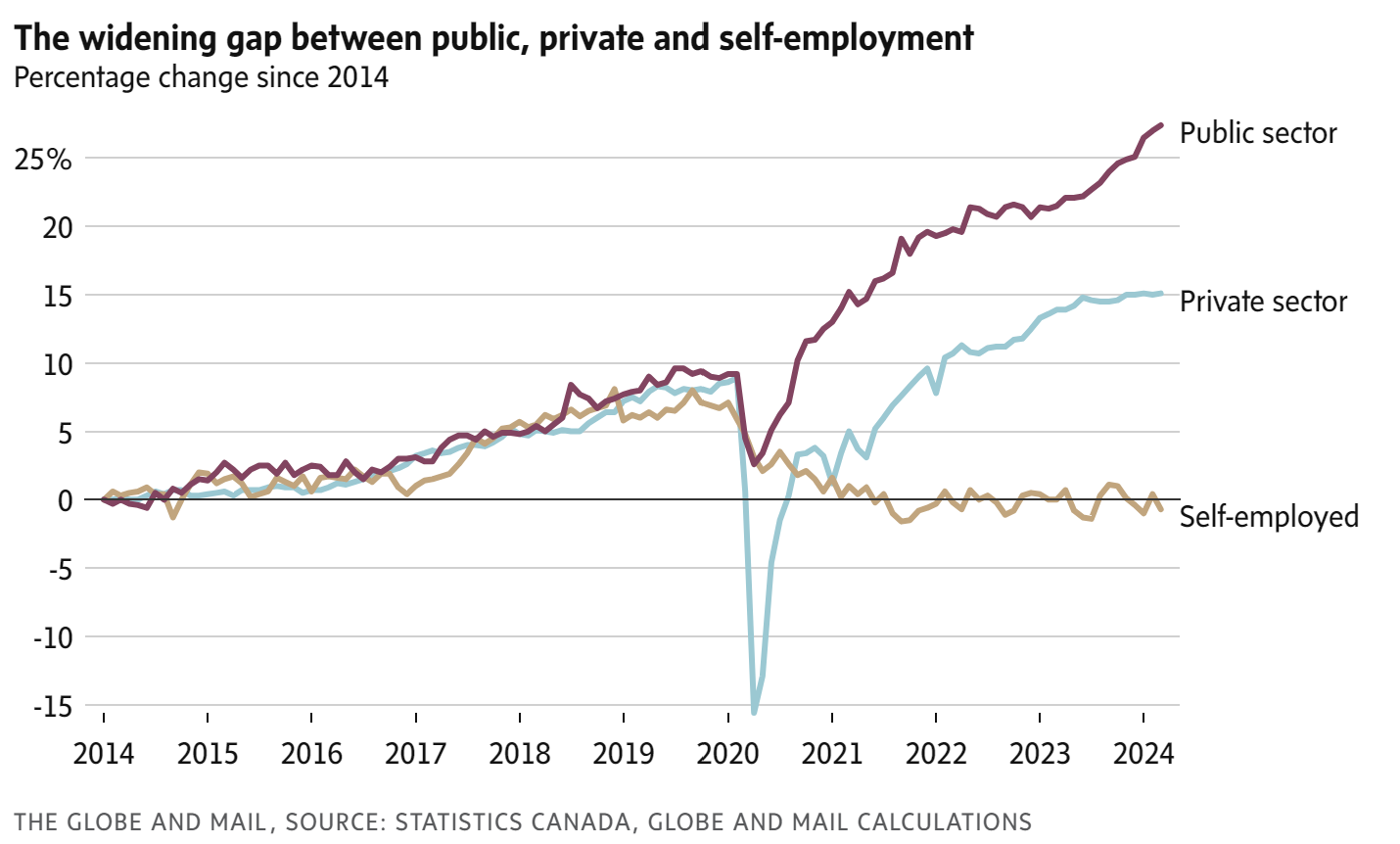Government Inefficiency Leads the Way to Productivity Woes
Post 40 | How about a different "Just Transition"?
My neighbour had his driveway paved by a company regularly used in our area. A crew of nearly a dozen rolled in at 7:30 am, unloaded equipment and set to work. Every man knew his job and rarely was idle more than a few minutes, while not rushing or raising voices as they worked in coordination to prep, lay asphalt, pave and tamp. Each sub-crew departed to the next job site after finishing their task, eventually leaving only two guys to finalize. This large job was completed in less than two hours – a symphony of efficiency with a great result.
A bit like these guys…
Meanwhile, last week my brother watched city employees remove three trees from a park across the street. Over the course of three days the job consumed about 60 man-days, a crane, a chipper truck and two bucket trucks with one sitting unused. Mornings began with coffee and chatting after which a few employees worked while others milled idly about, wrapping up by mid-afternoon each day. Any decent private company would have completed it in half the time, a third of the manpower and less machine use – saving thousands in the process.
These two local examples are reasonable proxies to highlight the difference between much of the private sector and public sector, centered around the attributes of efficiency and effectiveness.
Canada’s public sector now represents more than 24% of all employment in the country with 4,257,000 jobs (includes public administration at all levels of government, crown corporations, and other government institutions like schools and hospitals). The past year saw a 4.7% increase of 202,000 employees to these government rolls compared with only 122,000 (0.9% increase) in our private sector of more than 13 million workers. That private sector growth occurred 90% in Alberta.
Our federal public administration alone currently sits at about 357,000.
In short, the engine of innovation, growth and productivity - the private sector - is being beaten out by our own taxpayer money as we struggle to compete with our own government offering job security, competitive salaries, generous benefits and pensions. 2021-22 alone saw more than 730,000 applications for federal jobs as Canadians flock to the certainty of government employment. And self-employment is being throttled out of existence through excess regulations and a competitive environment stacked against them.
As extrapolated from the 2021 data below, Canada likely now ranks highest among the largest OECD countries in government jobs as a share of total employment. When you are worse than France in government bloat, you really should be concerned.
Efficiency can be described as how something is done, and effectiveness as its measurable outcome.
Inefficiency and ineffectiveness have long been entrenched in our public sector and I have chronicled many of our government’s fiscal and programmatic failings in prior posts. Effectiveness is practically a foreign language in that domain, as outcomes cannot be used to compel behaviour and they are being horribly leveraged as motivational tools.
According to data gathered from an Access to Information request by the Canadian Taxpayers Federation, federal employees met performance goals less than 60% of the time in 2022-23 (worse in 2020 at 48%). Yet, 89% received bonuses totaling $198 million. Of that money, 74% flowed to about 8200 executive level personnel.
This brings the bonus total to nearly $500 million since 2019. Meanwhile many public sector target goals that do exist might kindly be called soft. They are increasingly tied to DEI-related attributes and soft objectives, not performance targets to generate program-driven outcomes for Canadians.
Many are finally awakening to the dire state of our productivity (the rate of output per unit of labour). An April OECD report forecasts Canada’s productivity will be the worst of all 38 member countries over the next 40 years, while labour productivity has fallen in six consecutive quarters and 11 out of the last 12 quarters. Post 22 provides more detailed data on our productivity issues, while offering six principles to help us improve.
Suffice to say more effective outcomes are sorely needed in this country. And where improved efficiency is a major contributor to better outcomes, it is a key area to focus our improvement efforts.
This is increasingly difficult when our country’s primary job growth is driven by the government sector who boast the lowest productivity, and the government’s DNA drives them to keep spending more money and continue hiring.
Vicious - meet cycle.
Markets and shareholders provide quick feedback to private and publicly traded businesses whenever they stray. If sales fall, clients are dissatisfied or investment departs, businesses must quickly adjust their structure, employee mix, processes, training, product offering or service delivery.
The public sector contrastingly runs on inertia where adding on is often the reflex response. Compounding our ballooning bureaucracy problem, Trudeau’s government spent $15.7 billion on external consultants in 2022-23 alone, with a large portion of that in the amorphous management consulting category. As a tragicomic example, the Department of Natural Resources then spent $670,000 last year on these same management consultants to, “ensure that Canadians’ tax dollars are being used efficiently and being invested in the priorities that matter most to them.”
So, our oversized public service relies on external consultants to tell them how to be more efficient, while inefficiently consuming billions more in the process, and still not improving measurable outcomes. We continue to spend and do, but not produce.
My own career was spent working in smaller enterprises for whom a focus on efficiency and effectiveness was a daily reality and it reinforced my appreciation for their importance. That career also offered me an inside look at processes within hundreds of global businesses in a variety of domains – finance, insurance, manufacturing, distribution, resources, technology and more. Many tended toward quiet efficiency and others did so more aggressively. Some, particularly larger organizations, suffered considerable issues. But they were all compelled by competition and market forces to improve their outcomes and most pursued it avidly out of necessity.
Bloat and inefficiency are easily hidden in the world of government, with a slow feedback loop to citizens and elections as our lagging recourse. Thanks to dogged journalists and opposition parliamentarians, we get to see hints of what truly occurs inside government. But it sometimes now takes years for a single data request to meander through The Access to Information Act, as the government treats this basic democratic right as an affront, willfully blocking and delaying.
This all sits against a backdrop of complaints the past few weeks from federal public sector employees who will be required to work from the office three days per week, beginning in September - the poor dears. While there are variances and confounders in the data, studies point to upwards of 20% productivity reduction in the shift from onsite to remote work since Covid, adding to any innate inefficiencies. It appears not all jobs can be properly done while sitting at home in pajamas.
Given the huffing and puffing from unions you might think employees were being hitched to yokes and whipped across fields - their response being a study in entitlement and melodrama. More than a dozen union presidents sent a letter to Jagmeet Singh last week whining that the new policy is being implemented with “flagrant disregard for the rights and well-being of workers”, and “We demand leadership that champions the rights of workers, respects the principles of fair labour relations and upholds the values of democracy.”
Even Jagmeet may find it difficult to muster the required faux indignity on this one.
Our next federal government has a huge task ahead and will need a backbone of steel to reshape our civil service and crown corporations into something with a modicum of efficiency - in structure, size and a culture of outcomes. They will face strikes and backlash that I hope will be roundly condemned by Canadians while resisting the urge to backpedal from necessary changes.
But, I often believe we don’t truly WANT to get more efficient.
Everyone needs a job, to get paid and live a decent life. And it seems we have a societal agreement to turn a blind eye to inefficiencies, just put in the time, and pretend everything is fine - shades of The Matrix. In a perverse way we fear the consequences of greater efficiency, particularly since its reaper could come knocking on our own door.
Ever wonder what everyone is doing in the hundreds of shiny office buildings you regularly pass? How about in your own organization?
My wholly unscientific musing is that many large corporations could lay off 30% of their employees and barely miss a beat, while government could tolerate a 50% haircut.
Would this throw us into wild unemployment? Well, not exactly…
Mike Rowe of the Mike Rowe Works Foundation (who provide scholarships, mentorship and advocacy for the trades industry) notes the United States currently has 10.8 million job vacancies for skilled tradespeople – electricians, mechanics, plumbers, pipe fitters, carpenters and more.
While Canada’s absolute numbers are much lower, our proportional numbers are similar. The government’s Economic and Social Development website states, “...skilled tradespeople are in high demand to fill well-paying jobs and build rewarding careers. The most recent projections estimate about 700,000 skilled trades workers are expected to retire between 2019 and 2028, creating an ever-growing need to recruit and train thousands more.”
I couldn’t agree more about these proud and lucrative careers. So why are we continuing to drive everyone into post-secondary university degrees where graduates emerge with huge debt and struggle to find good work beyond the bosom of government? But let’s leave that discussion for another day.
Meanwhile, I feel a solution coming on…
I propose we take a page from the government’s own handbook where they talk a big game about repurposing a majority of our 70,000 oil & gas workers into the green energy world through their Just Transition plan, as they wage war against fossil fuels.
After we’ve privatized a good portion of our crown corporations, let’s repurpose and retrain a whole swath of the existing civil service and remaining crown employees into our unfilled trades. Let’s then apply reasonable outcome measurements to every remaining executive bureaucratic role, conditional to their ongoing employment, and continue that process down to individual job accountability. Just like it works in the real world.
This will save us billions, force streamlining, ratchet up accountability and put a dent in the woeful lack of skilled resources. It might even have a knock-on effect of building more of those houses we keep talking about.
Sounds like a just, efficient and effective solution, doesn’t it?
Stay tuned and stay pragmatic.








This one got under my skin ... meaning you are soooo right! Is there not ANYTHING we Canadians can do other than drop a ballot in the next election and hope and pray the next guys will be better to hold these people to account. The abuse of our money and setting Canada back in so many measures is unspeakable. Yet our only recourse is "vote them out"? There must be a better and different way. Thanks cuz for your writing ... it sure stirs the insides.